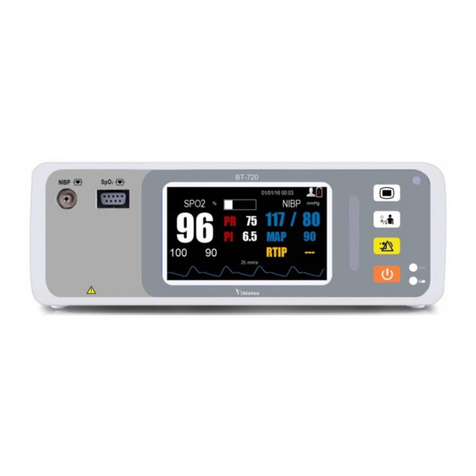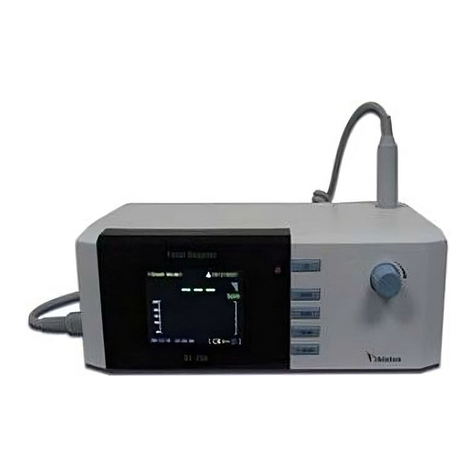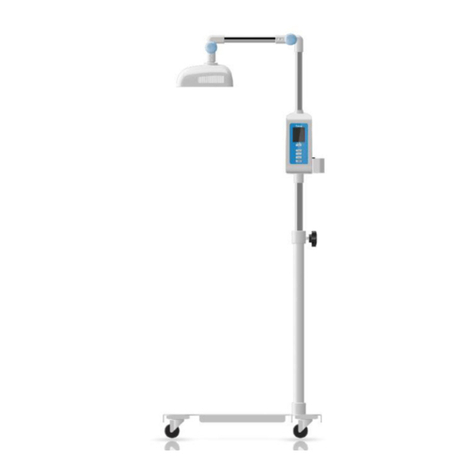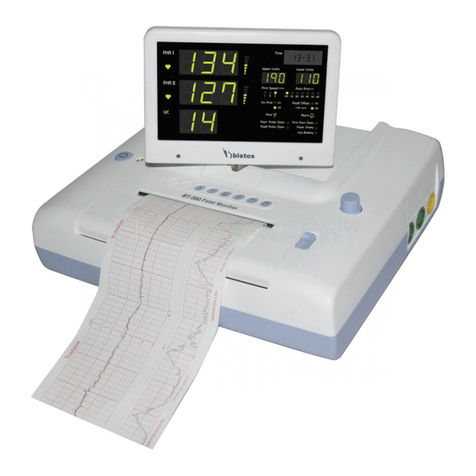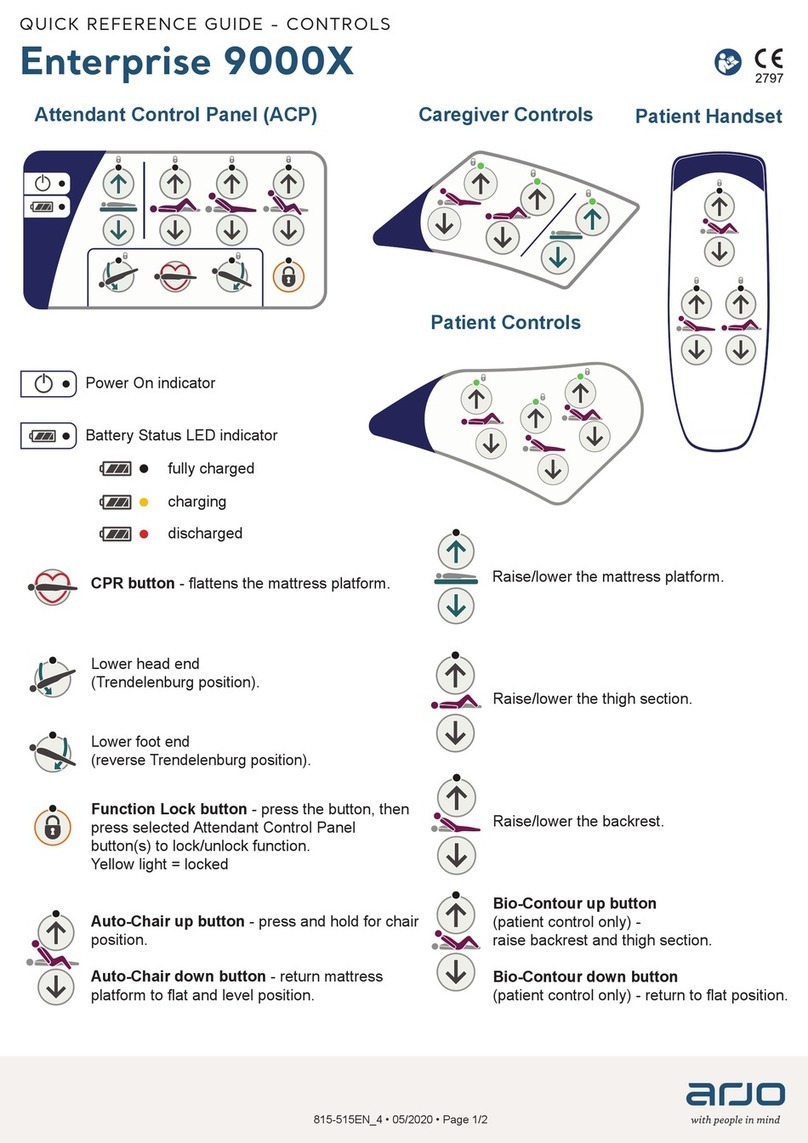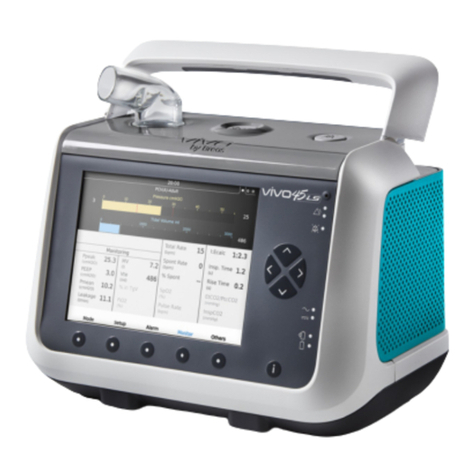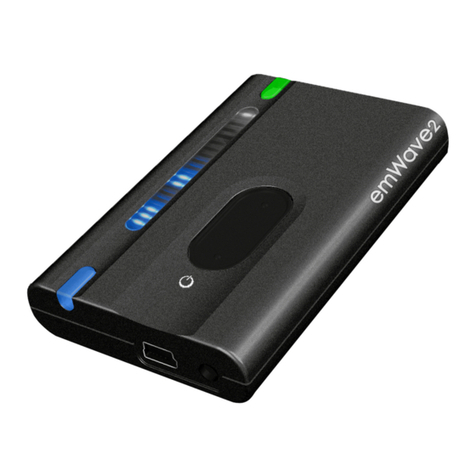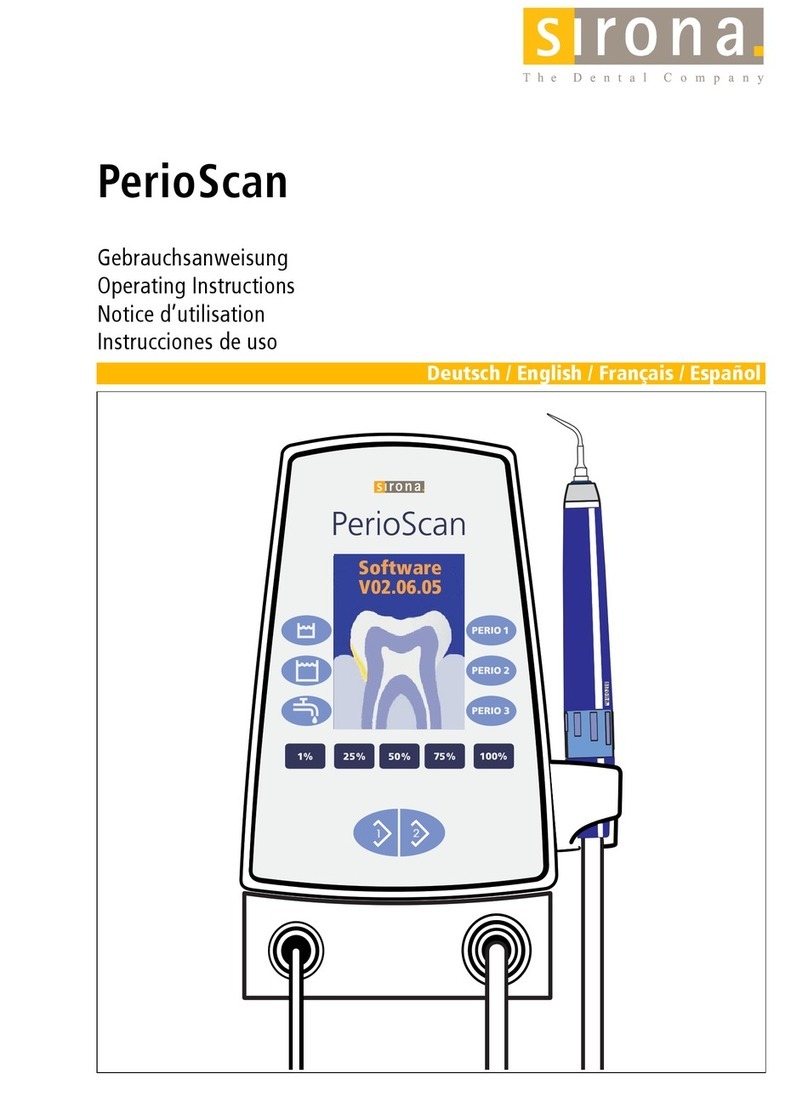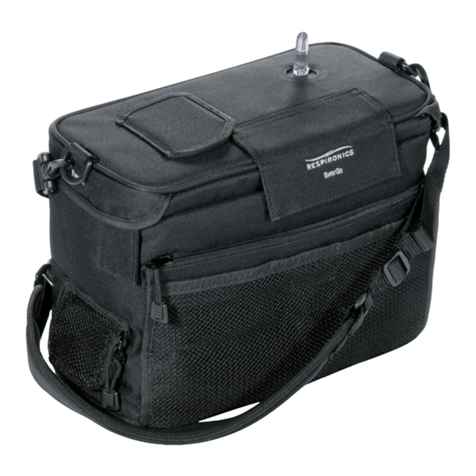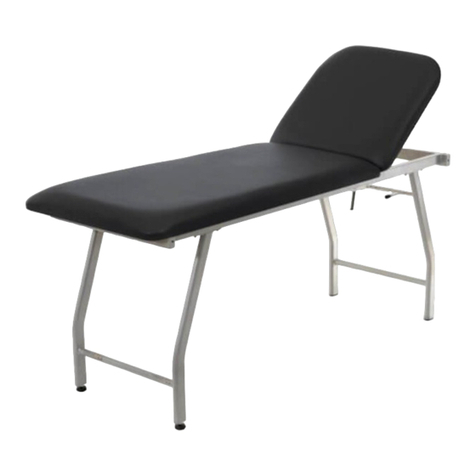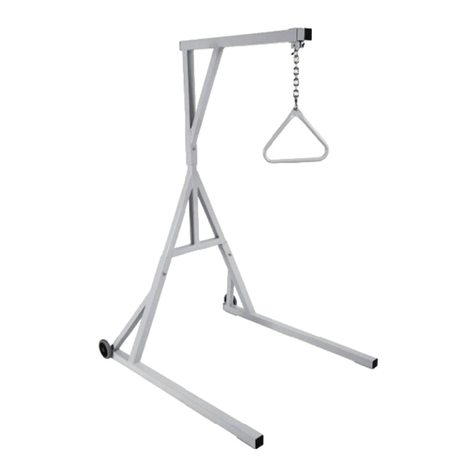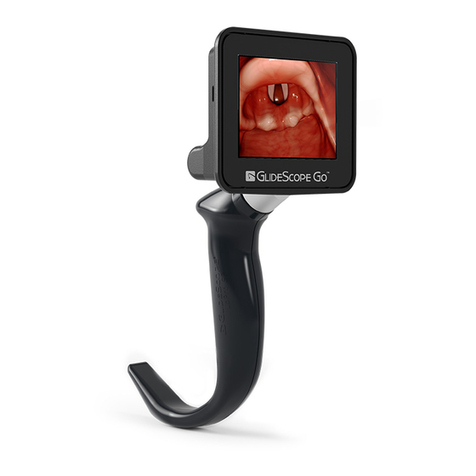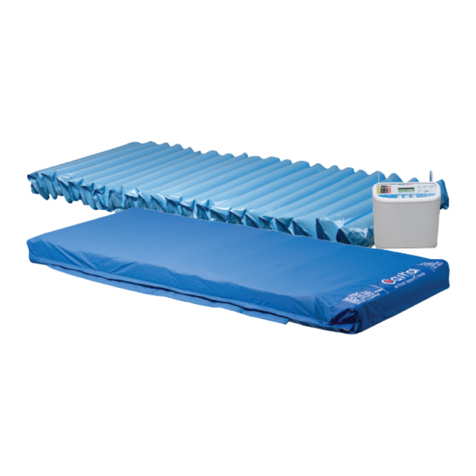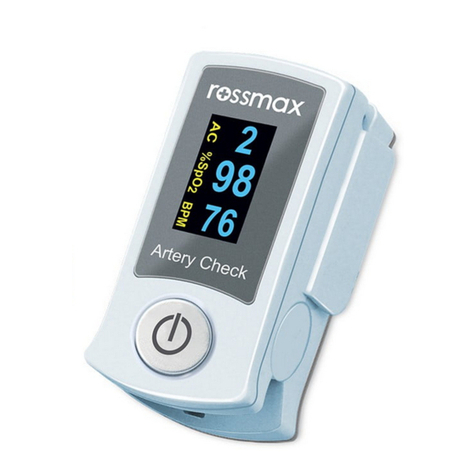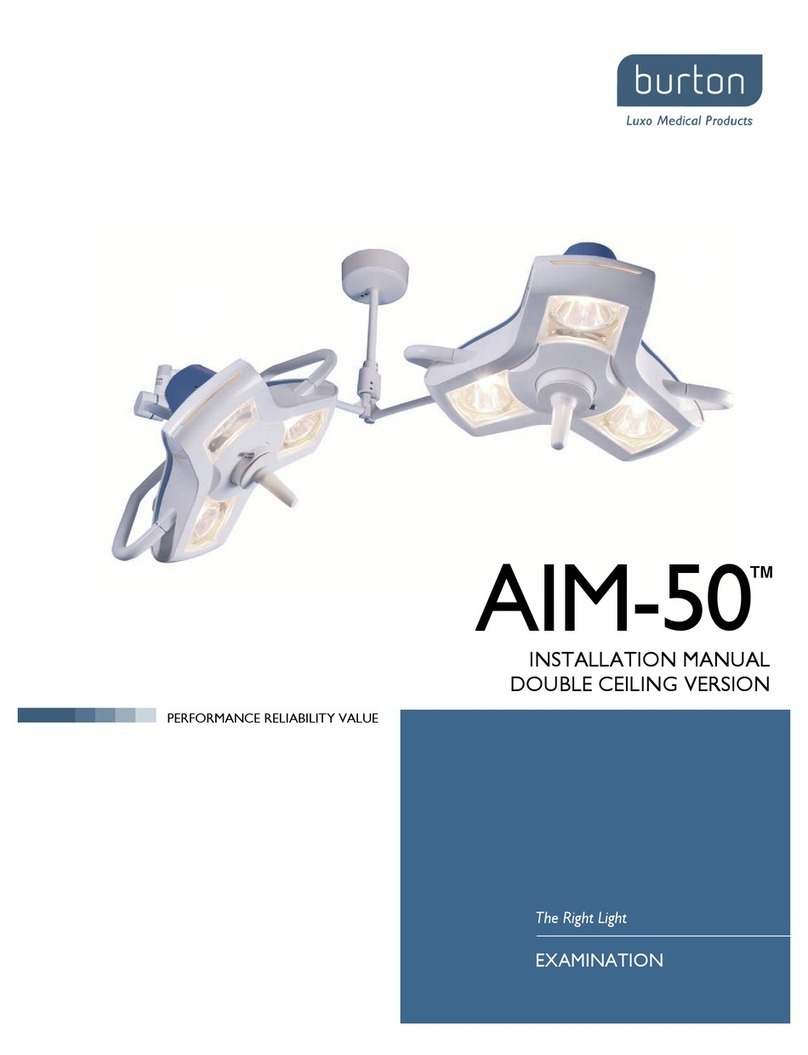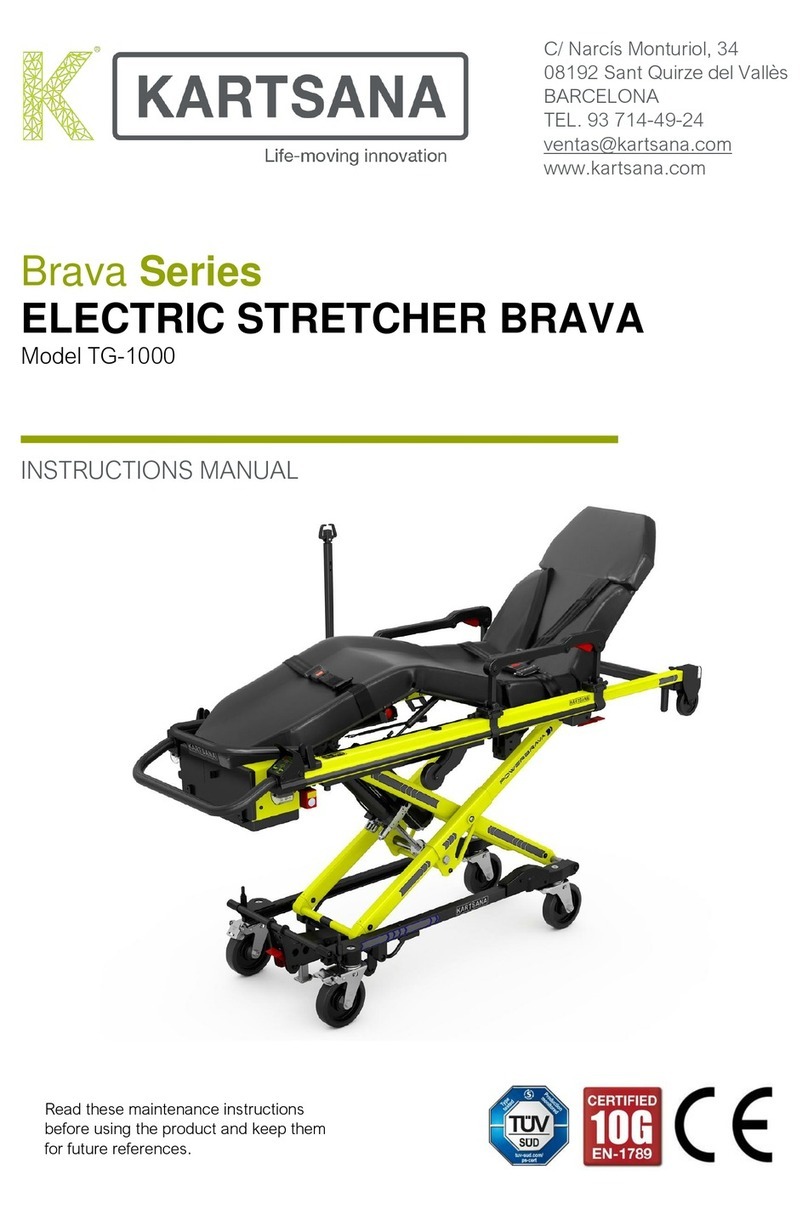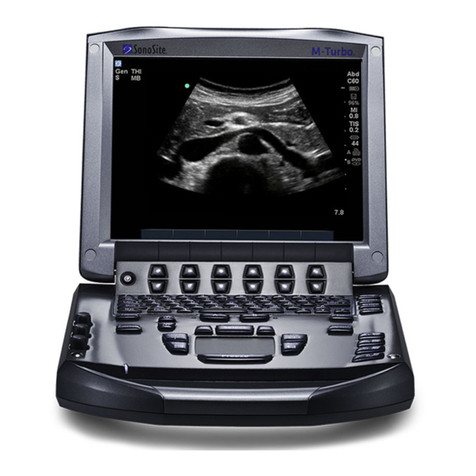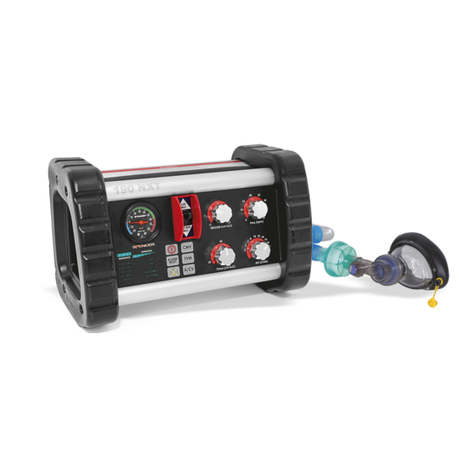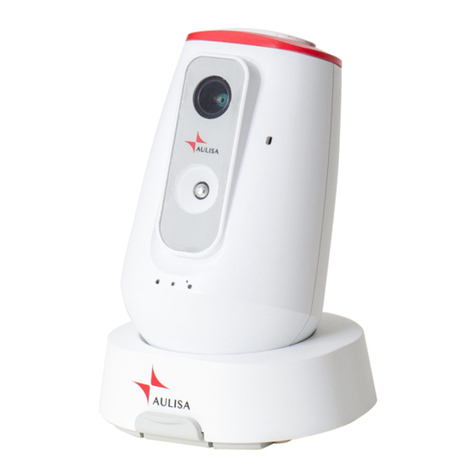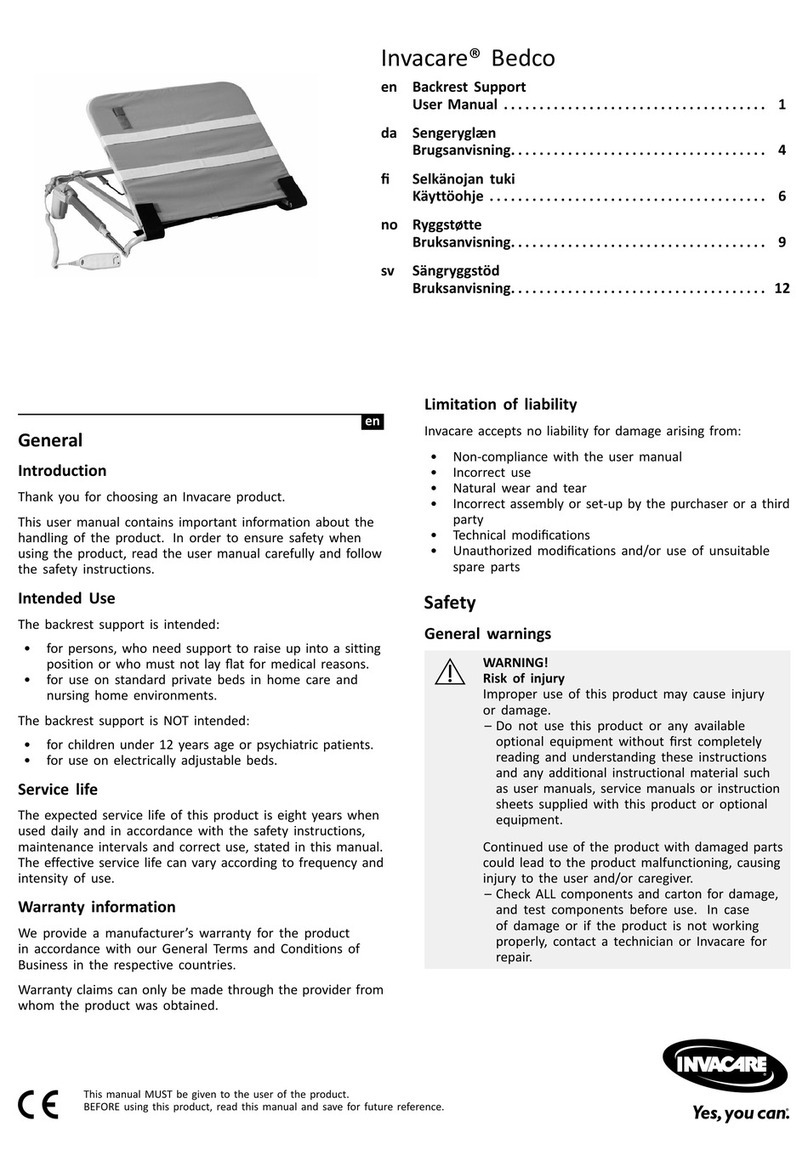Bistos BT-220 User manual

BT-220
Ultrasound Doppler System
Operation Manual
BT-220
Keep this manual for future reference
P/N: 220-ENG-OPM-EUR-R02

BT-220 Operation Manual
2
P/N: 220-ENG-OPM-EUR-R02
Bistos Co.,Ltd
2018,03
Proprietary Material
Information and descriptions contained in this manual are the property of Bistos Co., Ltd.
and may not be copied, reproduced, disseminated, or distributed without express written
permission from Bistos Co., Ltd.
Information furnished by Bistos Co., Ltd. is believed to be accurate and reliable.
However, no responsibility is assumed by Bistos Co., Ltd. for its use, or any infringements
of patents or other rights of third parties that may result from its use. No license is granted
by implication or otherwise under any patent or patent rights of Bistos Co., Ltd.
Revision 02
Mar,2018
Copyright © Bistos Co., Ltd. 2017. All rights reserved.
7th Fl., ABldg., Woolim Lions Valley 5-cha, 302, Galmachi-ro
Jungwon-gu, Seongnam-si, Gyeonggi-do, Korea
Telephone: +82 31 750 0340
Fax: +82 31 750 0344
Printed in Korea

BT-220 Operation Manual
3
P/N: 220-ENG-OPM-EUR-R02
Bistos Co.,Ltd
2018,03
Table of Contents
1. SAFETY .......................................................................................... 4
1.1 Instructions for the Safe Operation and Use of the BT-220 Doppler ................4
1.2 Warnings.............................................................................................................5
1.3 Cautions .............................................................................................................5
1.4 Definitions of Symbols........................................................................................7
2. INTROCUTION ................................................................................. 8
2.1 Product Overview...............................................................................................8
2.2 Indications for Use..............................................................................................8
2.3 Product Features................................................................................................8
2.4 Product Configuration.........................................................................................8
2.5 Exterior Component Designation .......................................................................9
3. OPERATION....................................................................................11
3.1 Controls and Indicators ....................................................................................11
3.2 Operation of BT-220.........................................................................................12
4. CLEANING & MAINTENANCE....................................................... 16
4.1 Main Body & Probe...........................................................................................16
4.2 Cable ................................................................................................................16
4.3 Battery Disposal and Handling.........................................................................16
4.4 Request a service for General Problems.........................................................16
4.5 Preventative Maintenance................................................................................17
5. SPECIFICATIONS .......................................................................... 18
6. DECLARATION ON EMC............................................................... 19
6.1 Electromagnetic emmission .............................................................................19
6.2 Recommended separation distances between portable and mobile RF
communications equipment and the BT-220 ...................................................19
6.3 Electromagnetic immunity................................................................................20
6.4 Immunity and Compliance Level ......................................................................22
PRODUCT GUARANTEE ..................................................................... 26

BT-220 Operation Manual
4
P/N: 220-ENG-OPM-EUR-R02
Bistos Co.,Ltd
2018,03
Section 1
Safety
1.1 Instructions for the Safe Operation and Use of the BT-220
Ultrasound Doppler System
Examine the device and any accessories periodically to ensure that the cable and
batteries do not have visible evidence of damage that may affect patient safety or
performance. The recommended inspection interval is once per week or less.
Do not use the device if there is any visible sign of damage.
Do not attempt to service the BT-220L and BT-220C. Only qualified service
personnel by Bistos Co., Ltd. should attempt any needed internal servicing
training.
BT-220L and BT-220C are not specified or intended for operation during the use
of defibrillators or during defibrillator discharge.
BT-220L and BT-220C are not specified or intended for operation in the presence
of electrosurgical equipment.
BT-220L and BT-220C are not specified or intended for operation in conjunction
with any other type of monitoring equipment except the specific devices that have
been identified for use in this Operation Manual.
Do not operate the BT-220L and BT-220C if it fails to pass the power on
procedure.
CAUTION
Be informed that it may cause no harm in life but lead to injury
against the “Caution” sign.
NOTE
Be informed that it may cause a potential hazardous situation
which, if not avoided, may result in minor or moderate injury.

BT-220 Operation Manual
5
P/N: 220-ENG-OPM-EUR-R02
Bistos Co.,Ltd
2018,03
1.2 Warnings
WARNING
EXPLOSION HAZARD — Do not use the BT-220 in a flammable
atmosphere where concentrations of flammable anesthetics or
other materials may occur.
SHOCK HAZARD — BT-220 doesn't have protection against the
burn injury caused by RF Surgical equipment. Do NOT use this
product along with RF Surgical equipment.
Use of cable or accessories which do not supplied or specified by
manufacturer can cause degrade of EMC characteristics or
negative effect on BT-220.
BT-220 should not use any active implantable or body- worn
medical device, including pacemakers, ICDs, neurostimulators, and
insulin pumps simultaneously.
No modification of this equipment is allowed. Do not modify this
equipment without authorization of the manufacturer. If this
equipment is modified, appropriate inspection and testing must be
conducted to ensure continued safe use of equipment.
1.3Cautions
CAUTION
The relevant law restricts this device to sale by or on the order of
a physician.
Keep the operating environment free of dust, vibrations, corrosive
or flammable materials and extremes of temperature and
humidity. The unit should be kept clean and free of transducer gel
and other substances.
If the equipment use in area where the integrity of the external
protective conductor in the installation or its arrangement is in
doubt, equipment shall be operated from its internal electrical
source when the optional battery is selected.
The equipment conforms to Internally powered equipment
according to IEC 60601-1 Medical Electrical Equipment - Part 1:
General requirements for basic Safety and essential performance
This equipment conforms to Class B according to IEC60601-1-2
Medical Electrical Equipment - Part 1-2 : General requirements
for basic Safety and essential performance – Collateral standard:
Electromagnetic compatibility

BT-220 Operation Manual
6
P/N: 220-ENG-OPM-EUR-R02
Bistos Co.,Ltd
2018,03
General Precaution on Environment
Do not keep or operate the equipment under the environment listed below.
Avoid placing in an
area exposed to
moisture. Do not
touch the equipment
with wet hand.
Avoid exposure to
direct sunlight
Avoid placing in an
area where there is a
high variation of
temperature.
Operating temperature
ranges from 10°C to
40°C. Operating
humidity ranges from
30% to 85%.
Avoid in the vicinity
of Electric heater
Avoid placing in an
area where there is an
excessive humidity
rise or ventilation
problem.
Avoid placing in an
area where there is
an excessive shock
or vibration.
Avoid placing in an
area where chemicals
are stored or where
there is in danger of
gas leakage.
Avoid dust and
especially metal
material into the
equipment.
Do not disjoint or
disassemble the
equipment.
BISTOS Co., Ltd.
does not take
responsibility of it.
Power off when the
equipment is not
fully installed.
Otherwise, the
equipment could
be damaged.

BT-220 Operation Manual
7
P/N: 220-ENG-OPM-EUR-R02
Bistos Co.,Ltd
2018,03
1.4 Definitions of Symbols
Symbol
Description
Requirements
Power On/Off Button IEC TR 60878
This symbol identifies a safety note. Ensure you
understand the function of this control before using it.
Control function is described in the operation manual. IEC60601-1
Type BF Equipment IEC60601-1
IPX7 IPX7 Waterproof
(1 meter of water for 30 minutes.) IEC60529
When disposing of some components, do not dispose
as general wastes.
Adhere to all applicable laws regarding recycling.
Directive
2002/96/EC &
EN50419
T
his symbol means an item is known to pose hazards
in all MRI environments. ASTM F2503-
13
※According to IEC 60601-1-6 General requirements for basic safety and essential performance
– Collateral Standard: Usability, the definition and using these symbols is adjusted.
CAUTION
Federal law restricts this device to sale by or on the order of a
physician..

BT-220 Operation Manual
8
P/N: 220-ENG-OPM-EUR-R02
Bistos Co.,Ltd
2018,03
Section 2
Introduction
2.1 Product Overview
BT-220 is a pocket-size fetal Doppler that measures the fetal heat rate and outputs the fetal heart
sound through built-in speaker. By measuring fetal heart rate(FHR), you are able to predict fetal
well-being. BT-220 irradiates Doppler sound wave to the abdomen of a pregnant woman to detect
the Doppler frequency signal and analyze, and displays the heart rate on screen. The device also
provides the heart sound from the heart of fetus.
2.2 Indications for Use
The BT-220L/220C is a pocket sized ultrasonic fetal monitor that measures heart rate, which is
displayed on an LCD display, and outputs fetal heart sounds through a built in speaker. The fetal
heart rate is measured using Doppler ultrasound.
2.3 Product Features
The BT-220 is a microprocessor-based fetal Doppler, which does display and output the fetal heart
rate and sound for antepartum testing.
①Compact (Pocket size) and light
②Easy to use
③Low Power consumption
④Long time use
⑤High quality sound
2.4 Product Configuration
BT-220 consists of the following. Unpack the package and check out the following items. Also be sure to
check any damage of main body, probe and accessories.
①BT-220 main body and probe
②1.5V Battery(2EA)
③Ultrasound transmission gel (1EA)
④User’s manual (1EA)

BT-220 Operation Manual
9
P/N: 220-ENG-OPM-EUR-R02
Bistos Co.,Ltd
2018,03
2.5 Exterior Component Designation
◎Front View, Top View & Right View
◊
BT-220L
①Custom Mono LCD
②Power Button
& Up/Down Button
③Indicator LED
④Sound Output
⑤Ear Phone Jack
◊
BT-220C
①TFT Color LCD
②Power and Mode Button
& Up/Down Button
③Indicator LED
④Sound Output
⑤Ear Phone Jack

BT-220 Operation Manual
10
P/N: 220-ENG-OPM-EUR-R02
Bistos Co.,Ltd
2018,03
◎Rear View, Bottom View & Left View
①Product Label
②Battery Compartment
③Probe Groove Joint
④Probe Connection and Charging Jack
◎Probe
①Sensor
②Probe Groove Joint
③Probe Connector

BT-220 Operation Manual
11
P/N: 220-ENG-OPM-EUR-R02
Bistos Co.,Ltd
2018,03
Section 3
Operation
3.1 Controls and Indicators
3.1.1 Buttons and Description
◊
BT-220L
Button
Description
It has function of AST On/Off
It has the function of volume down
It has the function of volume up
It has the function of power on/off
◊
BT-220C
Button
Description
It has function of display mode change
It has the function of volume down
It has the function of volume up
It has the function of power on/off
3.1.2 Symbols and Description
◊
BT-220C
Symbol Description
Battery indicator
Doppler volume indicator
Doppler volume mute indicator
Low battery indicator

BT-220 Operation Manual
12
P/N: 220-ENG-OPM-EUR-R02
Bistos Co.,Ltd
2018,03
3.1.3 Mode and Description
◊
BT-220C
Mode Description
This mode displays FHR as big number
This mode displays FHR as small number and graph
3.1.4 Automatic Shutdown
If the device is not in use for 1 minute, it stops the heart sound with "beep" sound, and
shutdown itself in 3 minutes with another "beep" sound.
If the battery voltage is dropped during the use, the device will shut down itself
automatically.
3.1.5 Use of Probe
Apply a liberal amount of ultrasound gel to the face of the end of the probe.
Place the probe directly against the measuring position.
Search for the fetal heart by slowly moving the probe around until the fetal heart sounds
are heard.
Search for the position which can get the clearest sound.
3.2 Operation of BT-220
3.2.1 Ready for use
1) Insert batteries
Open the battery cover on the back of the BT-220.
Insert the battery, ensuring the polarity.
Ultrasound transducer

BT-220 Operation Manual
13
P/N: 220-ENG-OPM-EUR-R02
Bistos Co.,Ltd
2018,03
2) connect the probe
Connect the connector , placing the “DOP” mark of connector upward
3) Use the ultrasound transmission gel
Put an suitable amount of ultrasound transmission gel on the probe sensor
3.2.2 Use of the product
3.2.2.1 BT-220L
1) LCD Information
<Measurement>
When Input signal is good and stable, FHR will appear on the screen and the solid heart
rhythm indicator will flash as shown in Figure.
When Input signal not stable, the outline heart rhythm indicator will flash.
If the voltage level of battery is lower than the required level, the battery low message ”bat
Lo” will appear as shown in Figure. In this case, the unit will not functional correctly and the
batteries should be replaced.
<Volume Level>
Press the volume up/down button to adjust the volume level (1~4).

BT-220 Operation Manual
14
P/N: 220-ENG-OPM-EUR-R02
Bistos Co.,Ltd
2018,03
2) Use the button
①
Power on/off
Press the
button to turn
on/off of product.
②
Volume up
Press the
button to turn
up the volume. (max level - 4)
③
Volume down
Press the
button to turn
down the volume. (min level- 1)
④
Speaker test
Press the button to check
the speaker operation.
3.2.2.2 BT-220C
1) FHR MODE INFORMATION
When Input signal is good and stable, FHR will appear on the screen and the solid heart
rhythm indicator will flash as shown in Figure. Refer to 3.1.5 for using probe.
①Heart Rhythm Indicator ②Herat rate(HR) Value
③Average of HR Mode ④Operating Time of FHR
⑤Function of Button ⑥Graph of HR
When Input signal not stable, the solid heart rhythm indicator will flash.
‘AVG’ represents the average value of the stable status of heart rate and ‘TIME’ represents
listening time of heat beat.
The bold lines of the graph mean a stable heart rate interval.

BT-220 Operation Manual
15
P/N: 220-ENG-OPM-EUR-R02
Bistos Co.,Ltd
2018,03
2) Use the button
①
Power on/off
Press the
button to turn
on/off of product.
②
Volume up
Press the
button to turn
up the volume. (max level - 4)
③
Volume down
Press the
button to turn
down the volume. (min level- 1)
④
Display mode
change
Press the
button to
change the display mode
3) AST(Speaker test)
Press the button in the MUTE status to AST function on/off. In the area of
‘function of button’ display, the [AST ON] and [AST OFF] are appeared.
You can hear the sound from speaker when press the button. If you press
the button, the device will return to the previously working mode(FHR
Number or Graph) with volume setting Level 1.

BT-220 Operation Manual
16
P/N: 220-ENG-OPM-EUR-R02
Bistos Co.,Ltd
2018,03
Section 4
Cleaning & Maintenance
This chapter contains instructions for the care and cleaning of the BT-220 unit and its
accessories.
The BT-220 requires proper care and preventive maintenance. If you use the material that
is not approved, it may cause any damage to the product. In this case, the product will not
be guaranteed even within the warranty period.
4.1 Main Body & Probe
To keep the device clean, apply ethanol for disinfection (alcohol) on a soft cloth and scrub
the body and the probe once a month. Do not use lacquer, thinner, ethylene, or the
oxidizing substance. Keep the probes from dust or stain.
Do not soak the main body and the probe into any liquid or detergent. Keep the main and
the probe away from any liquid.
CAUTION
Check the main body and the probe thoroughly after cleaning.
4.2 Cable
Wipe the cable with a soaked cloth that is wet with warm water (40℃/ 104℉), and with
the clinical alcohol(ethanol for disinfection) once a week.
WARNING
Do not autoclave. Do not gas sterilize.
4.3 Battery Disposal and Handling
NOTE
1.5V
ⅹ
2(AA Type) Batteries are used for the system power.
Do not use the other type of battery.
It could be the cause of breakdown.
If the battery has not enough power, the operation of equipment can be stopped abruptly.
Please check the battery power level to ensure the equipment operating for an appropriate
time period.
WARNING
Remove the battery if the device is not likely to be used for some
time.
4.4 Request a service for general problems
If the main body and probe are damaged by excessive mechanical forces, narrow cracks
or separation of ultrasonic sensor can be happened. These can be checked through visible
or auditory decision. These can cause malfunction some times. But these do not cause

BT-220 Operation Manual
17
P/N: 220-ENG-OPM-EUR-R02
Bistos Co.,Ltd
2018,03
unacceptable risks. If the BT-220 does not work properly, please contact us and change
the corresponding parts. Note that the replacement costs can be occurred.
4.5 Preventative Maintenance
Operators and service personnel should examine the device and any accessories
periodically to ensure that the cable and batteries do not have visible evidence of damage
that may affect patient safety or performance. The recommended interval of the
preventative maintenance inspection is once per week or less. Do not use the device if
there is any visible sign of damage.
Especially, qualified service personal should check that the main body and probe operate
normally according to BT-220 service manual (SVM(BT-220)EN) at least once a month.
WARNING
No modification of this equipment is allowed.
Do not modify this equipment without authorization of the
manufacturer. If this equipment is modified, appropriate
inspection and testing must be conducted to ensure
continued safe use of equipment.

BT-220 Operation Manual
18
P/N: 220-ENG-OPM-EUR-R02
Bistos Co.,Ltd
2018,03
Section 5
Specifications
BT-220 Ultrasound Doppler System Specifications:
General
Ultrasound Frequency
2 MHz, 3 MHz
Intensity
<10 mW/cm2
Heart rate range
BT-220L: 50~240 bpm
BT-220C: 30~240 bpm
FHR accuracy
±2bpm or 2% of range
Available pregnancy periods
10 ~ 12 weeks inward
Physical characteristics
Main body
(W)132
㎜
×(L)66
㎜
×(H)27.6
㎜
Probe (L)162 ㎜×(H)29.3 ㎜×(D)27.8 ㎜
Weight(Main body with probe)
BT-220L: 190 g
BT-220C: 200 g
Electrical safety
Compliance with IEC 60601-1, IEC 60601-1-2
Ultrasound Doppler system according to IEC 60601-2-37
Internal powered equipment
Type BF applied parts
Probe waterproof Level IPX7
Power
Battery
1.5V X 2 (AA type)
About 180 minutes for continuously use
Environmental conditions
Operation
Storage
Temperature
10
℃
(50
℉
) ~ 40
℃
(104
℉
)
-20
℃
(14
℉
) ~ 60
℃
(131
℉
)
Relative Humidity
30% ~ 85% non-condensing
Atmospheric pressure
79.051
㎪
~ 101.325
㎪

BT-220 Operation Manual
19
P/N: 220-ENG-OPM-EUR-R02
Bistos Co.,Ltd
2018,03
Section 6
Declaration on EMC
6.1 Electromagnetic emissions
The BT-220 is intended for use in the electromagnetic environment specified below.
The customer or the user of BT-220 should assure that it is used in such an
environment.
Emissions test
Compliance
Electromagnetic environment-guidance
RF emissions
CISPR 11 Group 1
The BT-220 uses RF energy only for its
Internal function. Therefore, its RF emissions
are very low and are not likely to cause any
interference in nearby electronic equipment.
RF emissions
CISPR 11
Class B
The BT-220 is suitable for use in all
establishments by using a battery.
Harmonic emission
IEC61000-3-2
Not applicable
Voltage fulctuations
/flicker emissions
IEC61000-3-3
Not applicable
6.2 Recommended separation distances between portable and mobile RF
communications equipment and the BT-220
The BT-220 is intended for use in the electromagnetic environment in which radiated
RF disturbances are controlled.
The customer or the user of the BT-220 can help prevent electromagnetic interference
by maintaining a minimum distance between portable and mobile RF communications
equipment (transmitter) and the BT-220 as recommended below, according to the
maximum output power of the communications equipment.
Rated maximum output
power of transmitter [W]
Separation distance according to frequency of
transmitter[M]
150 kHz to
80 MHz
= 1,2√
80 MHz to
800 MHz
= 1,2√
800 MHz to
2.5 GHz
= 2,3√
0.01
0.12
0.12
0.23
0.1
0.38
0.38
0.73
1
1.2
1.2
2.3
10
3.8
3.8
7.3
100
12
12
23

BT-220 Operation Manual
20
P/N: 220-ENG-OPM-EUR-R02
Bistos Co.,Ltd
2018,03
For transmitters rated at a maximum output power not listed above, the recommended
separation distance d in meters (m) can be estimated using the equation applicable to
the frequency of the transmitter, where pis the maximum output power rating of the
transmitter in watts (W) according to the transmitter manufacturer.
NOTE 1) At 80
MHz
and 800
MHz
, the separation distance for the higher frequency range
applies.
NOTE2) These guidelines may not apply in all situations. Electromagnetic propagation
is affected by absorption and reflection from structures, objects and people.
6.3 Electromagnetic immunity
The BT-220 is intended for use in the electromagnetic environment specified below.
The customer or the user of the BT-220 should assure that it is used in such an
environment.
Immunity test
IEC 60601
Test level
Compliance
level
Electromagnetic
environment-guidance
Electrostatic
discharge(ESD)
IEC 61000-4-2
±6 ㎸Contact
±8 ㎸air
±6 ㎸Contact
±8 ㎸air
Floors should be wood,
concrete or ceramic tile. If
floors are covered with
synthetic material, the
relative humidity should be
at least 30%.
Electrical fast
transient/burst
IEC61000-4-4
±2 ㎸for power
supply lines
±1 ㎸for
input/output lines
Not applicable
Mains power quality should
be that of a typical
commercial or hospital
environment.
Surge
IEC61000-4-5
±1 ㎸differential
mode
±2 ㎸common
mode
Not applicable
Mains power quality should
be that of a typical
commercial or hospital
environment.
Voltage dips, short
interruptions and
voltage variations
on power supply
input lines
IEC61000-4-11
<5%U
T
(>95% dip in UT)
for 0.5 cycle
40% UT
(60% dip in UT)
for 5 cycle
70% UT
(30% dip in UT)
for 25 cycle
<5% UT
(<95% dip in UT)
for 5s
Not applicable
Mains power quality should
be that of a typical
commercial or hospital
environment. If the user of
the BT
-220 image intensifier
requires
Continued
operation during
power mains interruptions, it
is recommended that the BT
-
220 image
. Intensifier be
powered from
a battery.
Power frequency
(50/60 ㎐)
magnetic field
IEC61000-4-8
3 A/m 3 A/m
Power frequency magnetic
fields should be at levels
characteristic of a typical
commercial or hospital
environment.
NOTE: UTis the a.c. mains voltage prior to application of the test level.
Other manuals for BT-220
1
Table of contents
Other Bistos Medical Equipment manuals

Bistos
Bistos BT-500 User manual
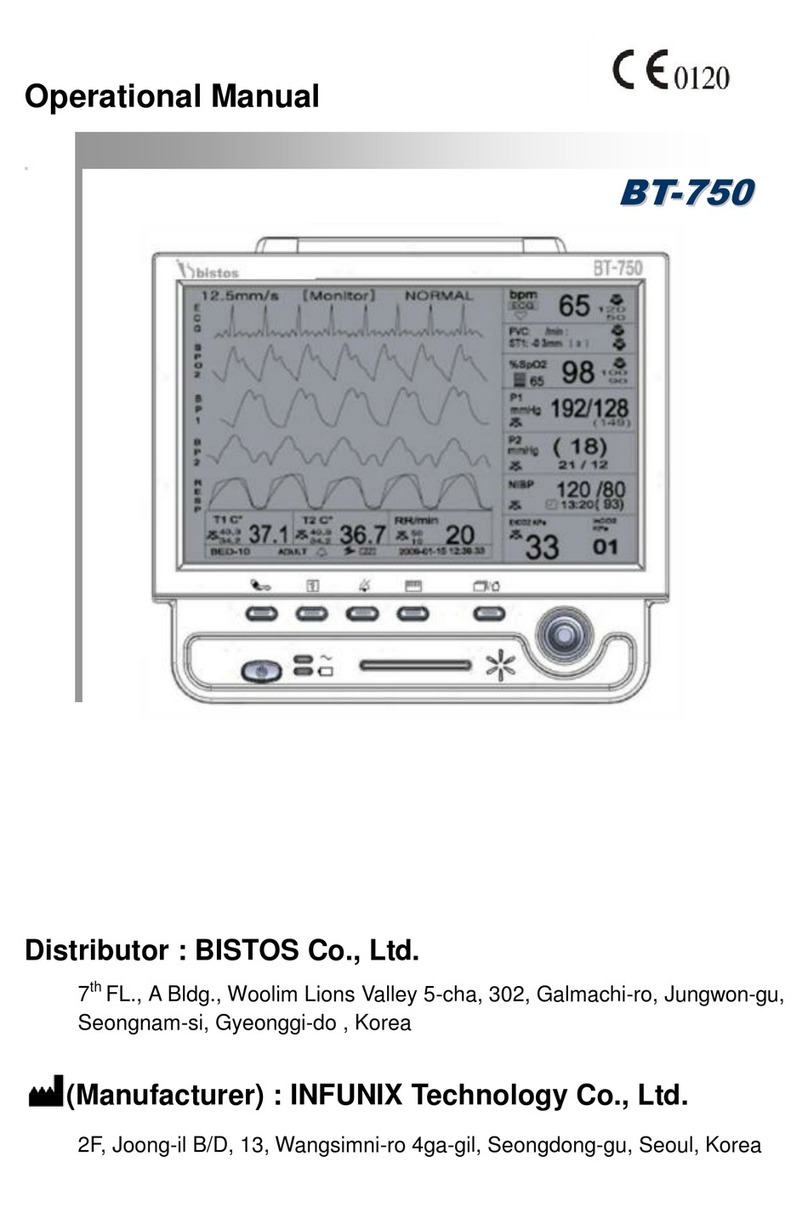
Bistos
Bistos BT-750 User manual

Bistos
Bistos BT-250 User manual
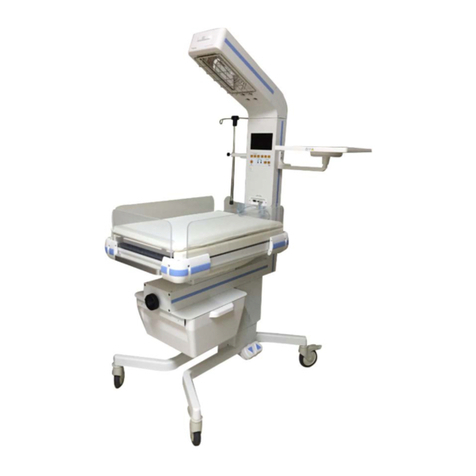
Bistos
Bistos BT-550 User manual
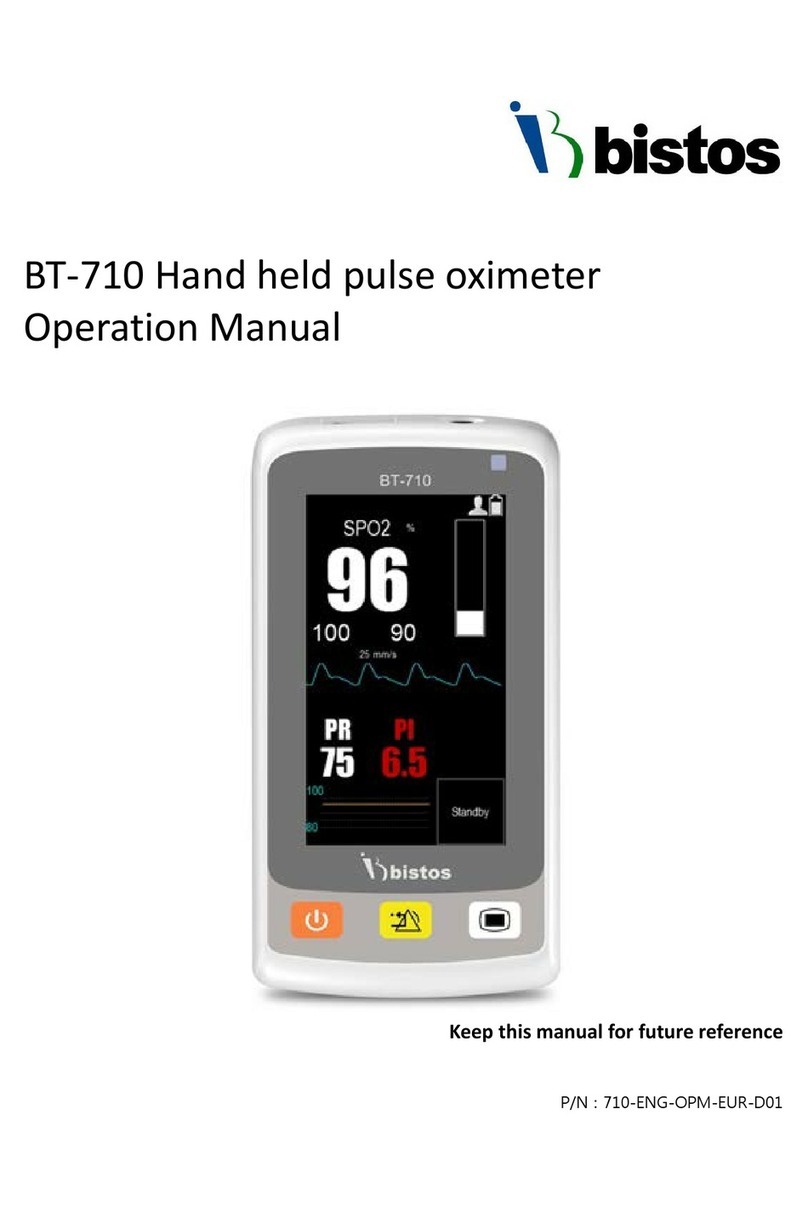
Bistos
Bistos BT-710 User manual

Bistos
Bistos BT-710 User manual
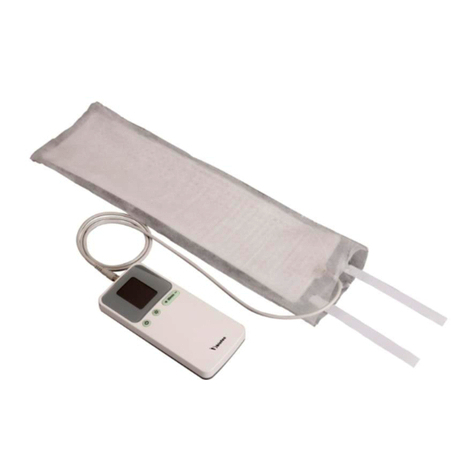
Bistos
Bistos BT-450 User manual

Bistos
Bistos BT-780 User manual
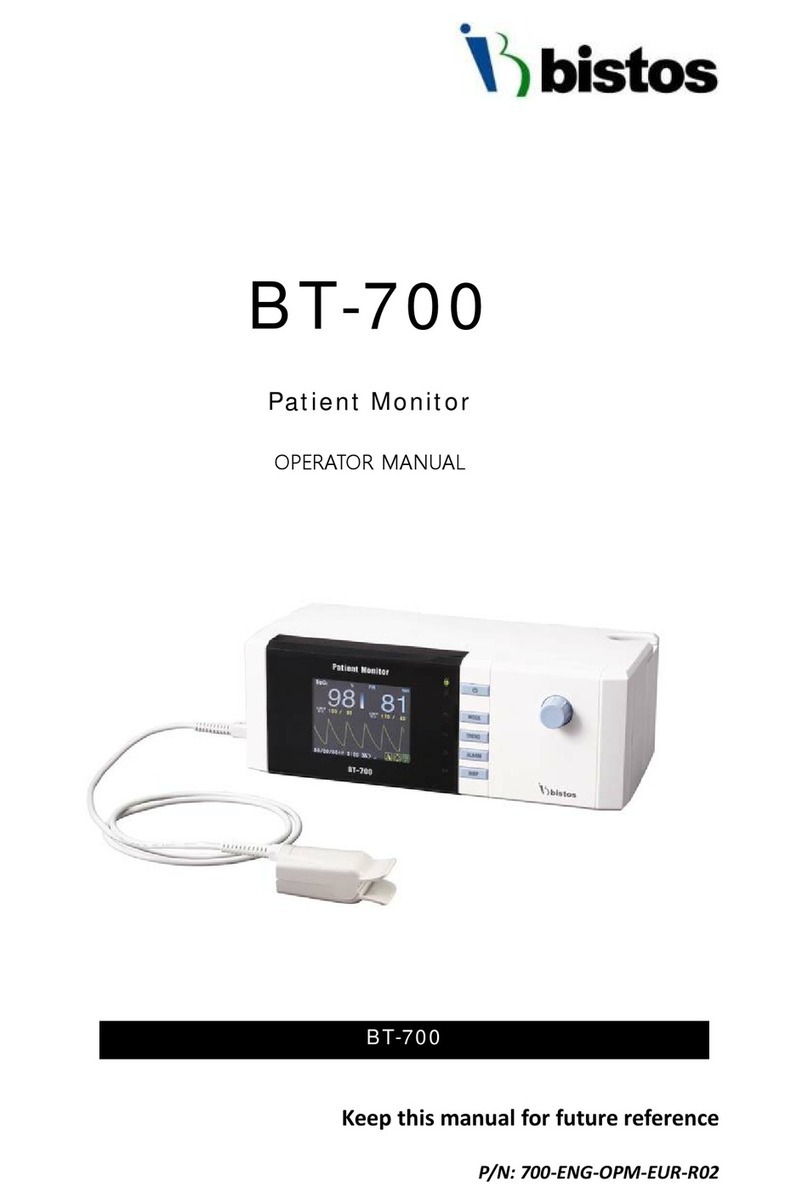
Bistos
Bistos BT-700 User manual
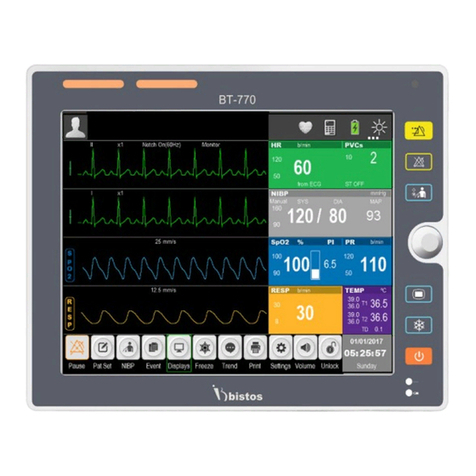
Bistos
Bistos BT-770 User manual
